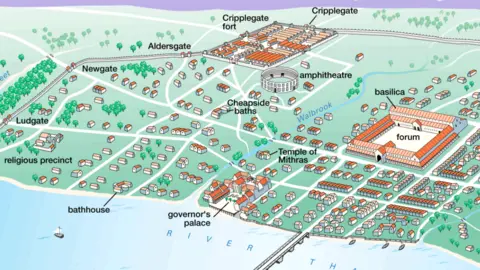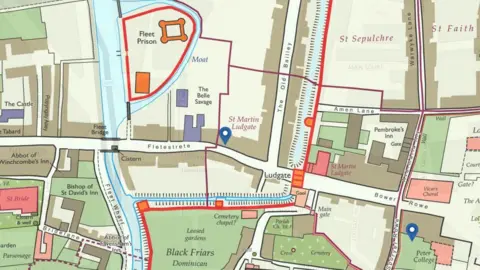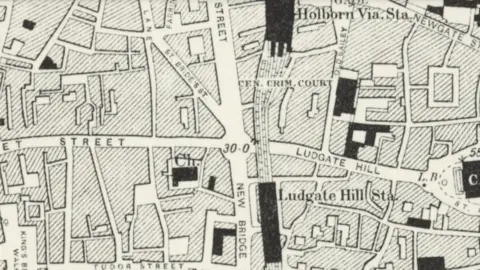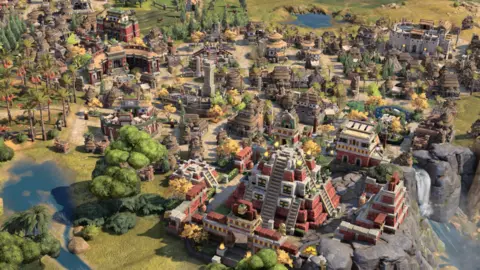 Firax
FiraxCivilization fans have waited nearly a decade for the latest installment in the cult video game series.
Now it turns out that the theme of the passing of time is quite fitting: the inspiration at the heart of Civilization VII, which will be released in February, is how the capital of the United Kingdom has changed from the Roman era to the present day.
And it all started with a map of Londinium – as London was known to the Romans.
“Londinium looked pretty much like any Roman frontier town with an amphitheater, baths and a swing bridge spanning the south side of the Thames,” observed the game’s lead developer Ed Beach as he showed me the map below – used here. courtesy of Encyclopedia Britannica.
“But I wanted to see how that evolved and how that changed as London grew and progressed.”
It’s the lessons from those changes that will lie at the heart of the new game.
 Encyclopaedia Britannica, Inc., 2004
Encyclopaedia Britannica, Inc., 2004The Civilization series has sold 70 million copies since it began in 1991 – with the last edition published in 2016.
The question of which direction developers Firaxis would take the next version of the game has been a hot topic among fans.
I include myself in that group – my brother first introduced me to Civ II on our PlayStation back in the ’90s, and I was recently a bit horrified to discover that I’ve spent more than 500 hours playing the sixth iteration of series.
For those who don’t know, Civilization is sometimes more like a board game than a video game. You move units around a map, placing cities and developing them as you fight others to conquer their land for yourself.
Previous games in the series have locked players into playing as a particular leader and civilization combination, such as Teddy Roosevelt and the United States, or Cleopatra and Egypt.
But developers say this is not really representative of how cities developed, with different ruling groups leaving their mark – as they have with London.
In the new game, a player can start out as the Romans, building their Londinium in what it calls the Age of Antiquity.
But once they progress to the next stage—the age of exploration in the game’s language—players can become Normans and build on what came before.
The game’s developers were inspired by Ludgate, the site of the western gate in the former London Wall, and dug up more old maps to see how the area had changed 1,000 years after the Romans left London.
“London changes, and it grows, but you can see that quintessential Roman camp,” Mr Beach said.
 Layers of London
Layers of Londonmap, produced by Layers of Londonpart of the UK Institute of Historical Research, shows that the River Fleet still flows – but most of the Roman-era buildings are no longer there.
“It’s all made up of the buildings you would expect in a medieval or renaissance era town,” Mr Beach said.
“We’ve got hostels, we’ve got taverns, we’ve still got religious buildings on the east side of the wall, but now it’s St Paul’s Cathedral, the first version of it, before it burned down in the fire of London.
“And we see that the river has been changed a bit so that they have a prison to hold some of those evildoers of the Middle Ages and keep them away.”
This change formed the foundation of the new game – building on what came before to create distinctly different eras.
Finally, the developers jumped forward in time to the Victorian era, to see how the Ludgate area had changed once again.
 National Library of Scotland
National Library of ScotlandThis map, reproduced by permission of the National Library of Scotland, shows another significant set of changes – with the River Fleet now no longer visible after being moved underground for sewage use in the mid-1960s 1800.
“Now the prison has been completely replaced, the needs of the industrial revolution dictate that we need a railway line there and Ludgate railway station is right on top of where the prison used to be,” Mr Beach said.
“All those buildings that once supported religious activity have been more or less overcome, with the exception of St. Paul’s Cathedral.”
This third phase of change – which the new game calls the modern era – solidified the concept for the developers.
In the example of London, players could play as the Romans, then the Normans, then Britain – all the while building a growing England that goes beyond the capital.
 Firax
FiraxWish list of changes
But while the big change in style may be exciting for some, die-hard fans of the series may be concerned about how different it is.
It comes amid many other changes that will be significant to fans – though they won’t mean much to people who haven’t played the game.
The game developers tell me that the computer controlled civilizations will behave more intelligently. They list the seemingly endless changes like deleting a list – each civilization has its own unique set of civilizations that can be discovered, units can now travel across rivers, and there are no more builders.
There are expected changes – like a graphical overhaul that makes the game look modern – and also unexpected ones – like changing the leaders you play as to include important historical figures who didn’t lead their country, like Benjamin Franklin and Confucius.
Meanwhile Hatshepsut, one of Egypt’s historical female leaders, is now playable. The game’s narrator — Game of Thrones and Star Wars actress Gwendoline Christie — adds a gravitas layer to the visual enhancement.
 Firax
FiraxBut not everything is taken straight from a fan’s wish list.
Roads will still be built automatically by merchants, which has long been a sore point for some players. There are some gameplay changes for the religion, but it still feels like players will be micro-managing missionaries around the map.
And the big promises of AI regulation are well received, but without seeing the final product it’s hard to be convinced.
The movement between the ages appears to be linked to crises – such as barbarian invasions, civil wars and plagues – although exactly how this will work is unclear.
Mr. Beach said he developed a “cool cycle that you go through three times in the game that we’re releasing here first” – a sentence that I said sounded suspiciously like Firaxis might consider adding more cycles and empires in the future.
He would not draw on it.
But one thing that seems certain is that by actually having a big reset button between periods, no player can go ahead and take an undisputed lead early in each game, which will be music to fans’ ears. .
We’ll find out when the game comes next year.
